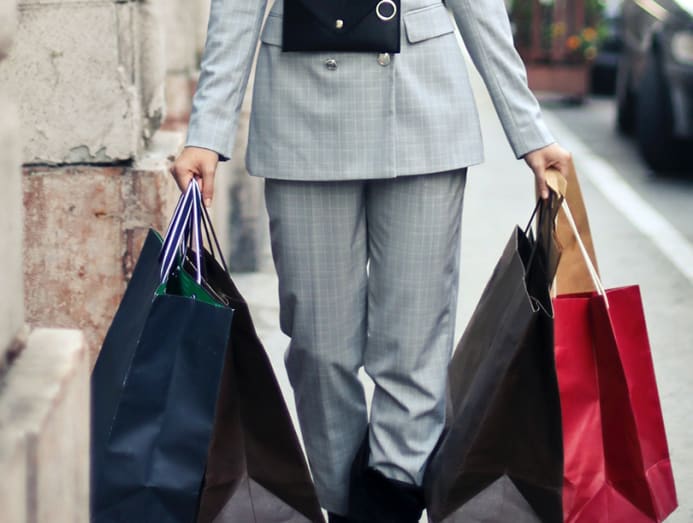Light after the lockdown: What the future of fashion and luxury will look like
Not since 1939 have the worlds of mode and luxury then completely ground to a halt. Stores are closed, orders cancelled, factories shut or repurposed to make PPE. The summertime way shows take been called off, and information technology looks increasingly unlikely the September fashion weeks will get ahead – brands such equally Saint Laurent and Tory Burch have already cancelled their shows.
No question, the COVID-19 pandemic has ushered in a reckoning for the £2.two trillion (Due south$iii.viii trillion) way and luxury industries – much of information technology around sustainability (and fashion's lack thereof). What volition emerge? Could a more responsible sector – one less damaging to the environment, that goes further to ensure the welfare of its workforce – materialise in its wake?
Environmentalists are certainly hoping and then. The fashion industry has been making far too much for far too long. Clothing production has become so toll-constructive at scale that brands would rather over-manufacture past xxx to twoscore per cent than risk running out of stock. Much of that excess ends upwards incinerated or in landfills – Burberry famously burnt £28.6m in bags, clothes and perfume in 2022 to prevent them from existence stolen or sold for too piddling (a exercise it has since halted).
Since Europe went into lockdown, designers and executives from Giorgio Armani to Vetements' Guram Gvasalia have been calling for change. They desire their peers to produce less and less often. They want customers to buy more at full-price, and are petitioning retailers to realign the sales agenda so that summer sandals and dresses are discounted at the end of the flavor, in late September, rather than June. (Right now, affluent with excess inventory, they are belongings sales earlier than ever.) They are asking for an cease to retail contracts where designers are given no gild deposits and no security, and which leave designers financially liable for what stores can't sell at full price.

READ> Equally Paris'south coronavirus lockdown eases, luxury stores examination the water
Many of these demands are wishful thinking. Independent designers will non secure amend terms with retailers, who will exist more than beholden to creditors and large brands – and less able to make risky bets on bottom-known names – than earlier. Nor will suppliers obtain better terms with designers – with so few orders coming in, brands volition be asking for discounts, and they will get them. Garment workers will in turn find it fifty-fifty more difficult to secure a living wage.
Changes nether way prior to the pandemic will accelerate. The big luxury brands, backed by even bigger conglomerates – namely LVMH and Kering – will rebound first and capture fifty-fifty more market share. The few globally recognised names that maintained their independence in the wake of the 2008 crisis – Prada, Ferragamo, Burberry, Tod's – may take a look at their residual sheets and reconsider. Section stores volition proceed to consolidate and disappear – not just in North America, but perhaps also in Europe, which is more dependent on tourists.
Chinese shoppers, who were already shopping more at habitation following VAT cuts and a crackdown on daigou (personal shoppers who import luxury goods into Prc without paying duties), will exist more likely to buy an Hermes bag in Shanghai than Paris or Hong Kong. Brands volition close stores in uppercase cities and tourist destinations every bit a result.

READ> Revenge spending? Hermes store in China hauls in South$3.8m a day after reopening
It won't exist all doom and gloom. Mode's impact on the surroundings – the amount of carbon information technology produces, the millions of litres of dye that pollute the world'south waterways, its contributions to soil erosion and biodiversity loss – will drib sharply this twelvemonth. Labels will produce fewer, smaller collections over the side by side few quarters, fifty-fifty years. Having seen the risks of a global supply chain, American brands will reinvest in local manufacturing, furnishing new jobs and skills.
Seasonal trends will go along to disappear equally designers focus more on archetype items that tin be worn year-round – and stay on shop shelves longer. The shift to more restrained, timeless pieces will ultimately give manner to exuberance and excess – just as wartime fabric rationing paved the way for Dior's New Await in 1947, and the 2008 financial crisis set the stage for Alessandro Michele's Gucci debut in 2015.
Style shows will get a much-needed overhaul. Already, the volume of resources poured into 10-minute shows – sometimes involving two full days of travel to see a single collection in Rio or Marrakesh – felt outrageous amid a climate crisis. They are also boring to scout online. Instead, brands volition experiment with digital presentations and live interactions with designers. Storytelling around brands and collections will improve as a consequence. It already has.
Fashion weeks will be smaller. Many designers won't be able to afford to host them. Nor volition magazines take the budgets to ship editors to nourish them. Deep-pocketed brands will fill seats with more influencers, exerting yet more control over third-party coverage. Unable to host showroom appointments, brands will invest in amend showroom software, leaving buyers with less reason to travel in the long-term. This will exist adept for the industry's carbon footprint.

Shopping habits will change. With less disposable income, consumers volition be more conscious of what they buy, treating luxury items as investment pieces that volition serve them for years – or at least hold their resale value. The shift in spending from high-cease handbags to wellness – skincare, supplements, boutique fitness classes – already on the rise pre-pandemic, volition proceed. Online shopping will go more of a habit. Similar to the 2008 recession, there will be more than support for buying second-hand and directly from small-scale businesses who manufacture responsibly. Others will turn to fast fashion for cheap thrills.
Ostentatious purchases volition be out – athleisure, which was losing its appeal, volition be back in. To quote GQ, nosotros are living in the age of sweatpants and are never going dorsum.
Past Lauren Indvik © 2022 The Financial Times
READ> What Asian women are buying online to brand themselves experience improve
starlingcloonstaked.blogspot.com
Source: https://cnalifestyle.channelnewsasia.com/obsessions/future-of-fashion-and-luxury-industry-251216
0 Response to "Light after the lockdown: What the future of fashion and luxury will look like"
Postar um comentário